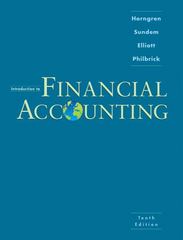Question
EXERCISE 3 (Adapted) Entity A raises cattle, slaughters them at its abattoirs, and sells the carcasses to the local meat market. How do we classify
EXERCISE 3 (Adapted) Entity A raises cattle, slaughters them at its abattoirs, and sells the carcasses to the local meat market. How do we classify the cattle and its carcass, after slaughtering? Cite the appropriate standard to classify it.
EXERCISE 4 (Adapted) Entity B grows vines, harvest the grapes, and produces wine. How do we classify the vines, the harvested grapes, and the wine? Cite the appropriate accounting standards to classify it.
EXERCISE 5
True or False:
______________ 1. In calculating the cost to sell of a biological asset, transportation expenses is
included.
______________ 2. When agricultural produce is harvested, the harvest shall be accounted for by
using PAS 2, Inventories. The cost at the date of harvest is deemed to be the accumulated costs.
______________ 3. The gross profit method of inventory is not valid or useful when the gross margin
rate is predictable or constant over time.
______________ 4. If the gross profit is based on cost, the sales are multiplied by the cost ratio.
______________ 5. A major advantage of the retail inventory method is that it gives a more accurate
amount of inventory than other methods.
Let's Analyze
PROBLEM 15
(Adapted) Althea Nicole Company is a producer of coffee. The entity is considering the valuation of
its harvested coffee beans. Industry practice is to value the coffee beans at market value and uses it
as a reference to a local publication.
On December 31, 2020, the entity has harvested coffee beans costing P1,500,000 and with a fair value
less cost to sell of P1,900,000 at the point of harvest. Because of the long aging and maturation process
after harvest, the harvested coffee beans were still on hand on December 31, 2021. On that date, the
fair value less cost to sell is P2,000,000, and the net realizable value is P1,850,000.
Requirements:
1. How much is the cost of the inventory of coffee beans?
2. What is the LCNRV of the inventory of coffee beans on Dec. 31, 2021?
3. Prepare the journal entry to record the adjustment of inventory on December 31, 2021?
PROBLEM 16
Herald Company has different kinds of farm animals on January 1, 2020. During the year, several
acquisitions occurred related to these farm animals. A detailed summary of these transactions is as
follows:
Carrying value on January 1, 2020
Qty Amount
2-year old Hogs 20 P180,000
2.5-year old Hogs 10 190,000
1-year old Horses 15 650,000
3-year old Cattle 10 950,000
Purchases on June 30, 2020
1.5-year-old Hogs 15 P230,000
Fair value less cost to sell on December 31, 2020
2-year old Hogs 20 P190,500
2.5-year old Hogs 10 201,000
1-year old Horses 15 675,000
3-year old Cattle 10 925,000
1.5 year old Hogs 15 240,000
Fair value less cost to sell on December 31, 2020
3-year old Hogs 20 P202,500
3.5-year old Hogs 10 204,000
2-year old Horses 15 670,000
4-year old Cattle 10 935,000
2-year old Hogs 15 246,500
There were no animals sold or born during the year.
Requirements:
1. Compute the biological asset at the end of December 31, 2020.
2. Compute the unrealized holding gains or losses attributable to price changes and physical
change.
3. Prepared the necessary entries to record the above transactions.
Step by Step Solution
There are 3 Steps involved in it
Step: 1

Get Instant Access to Expert-Tailored Solutions
See step-by-step solutions with expert insights and AI powered tools for academic success
Step: 2

Step: 3

Ace Your Homework with AI
Get the answers you need in no time with our AI-driven, step-by-step assistance
Get Started


